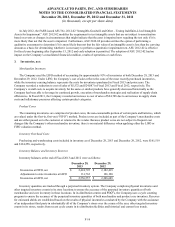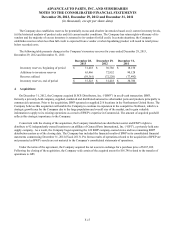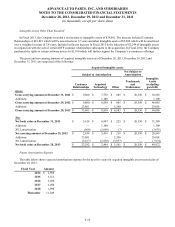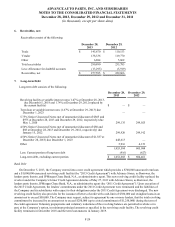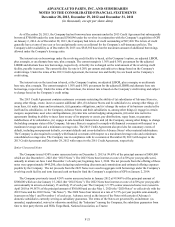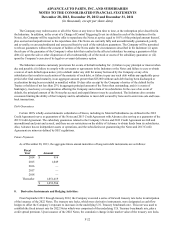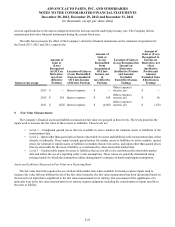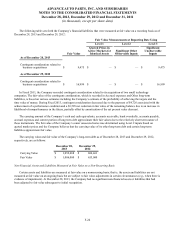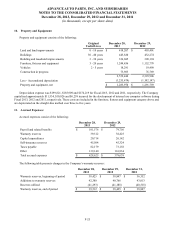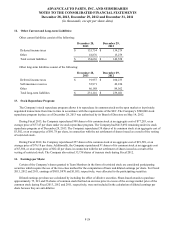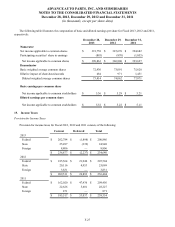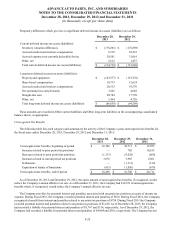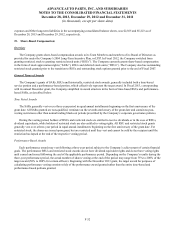Advance Auto Parts 2013 Annual Report Download - page 75
Download and view the complete annual report
Please find page 75 of the 2013 Advance Auto Parts annual report below. You can navigate through the pages in the report by either clicking on the pages listed below, or by using the keyword search tool below to find specific information within the annual report.
ADVANCE AUTO PARTS, INC. AND SUBSIDIARIES
NOTES TO THE CONSOLIDATED FINANCIAL STATEMENTS
December 28, 2013, December 29, 2012 and December 31, 2011
(in thousands, except per share data)
F-23
was not significant due to the narrow margin between the lock rate and the underlying treasury rate. The Company did not
maintain any derivative financial instruments during the current fiscal year.
The table below presents the effect of the Company’s derivative financial instruments on the statement of operations for
the Fiscal 2013, 2012 and 2011, respectively:
Interest rate swaps
Amount of
Gain or
(Loss)
Recognized
in OCI on
Derivative,
net of tax
(Effective
Portion)
Location of Gain or
(Loss) Reclassified
from Accumulated
OCI into Income
(Effective Portion)
Amount of
Gain or
(Loss)
Reclassified
from
Accumulated
OCI into
Income, net
of
tax (Effective
Portion)
Location of Gain or
(Loss) Recognized in
Income on
Derivative
(Ineffective Portion
and Amount
Excluded
from Effectiveness
Testing)
Amount of
Gain or (Loss)
Recognized in
Income on
Derivative, net
of tax
(Ineffective
Portion and
Amount
Excluded from
Effectiveness
Testing)
2013 $ — Interest expense $ —
Other (expense)
income, net $ —
2012 $ 254 Interest expense $ 108
Other (expense)
income, net $ 66
2011 $ (254) Interest expense $ (4,807)
Other (expense)
income, net $ (132)
9. Fair Value Measurements:
The Company’s financial assets and liabilities measured at fair value are grouped in three levels. The levels prioritize the
inputs used to measure the fair value of these assets or liabilities. These levels are:
• Level 1 – Unadjusted quoted prices that are available in active markets for identical assets or liabilities at the
measurement date.
• Level 2 – Inputs other than quoted prices that are observable for assets and liabilities at the measurement date, either
directly or indirectly. These inputs include quoted prices for similar assets or liabilities in active markets, quoted
prices for identical or similar assets or liabilities in markets that are less active, and inputs other than quoted prices
that are observable for the asset or liability or corroborated by other observable market data.
• Level 3 – Unobservable inputs for assets or liabilities that are not able to be corroborated by observable market
data and reflect the use of a reporting entity’s own assumptions. These values are generally determined using
pricing models for which the assumptions utilize management’s estimates of market participant assumptions.
Assets and Liabilities Measured at Fair Value on a Recurring Basis
The fair value hierarchy requires the use of observable market data when available. In instances where inputs used to
measure fair value fall into different levels of the fair value hierarchy, the fair value measurement has been determined based on
the lowest level input that is significant to the fair value measurement in its entirety. Our assessment of the significance of a
particular item to the fair value measurement in its entirety requires judgment, including the consideration of inputs specific to
the asset or liability.





